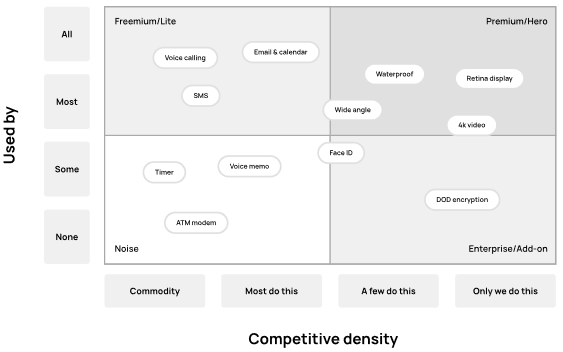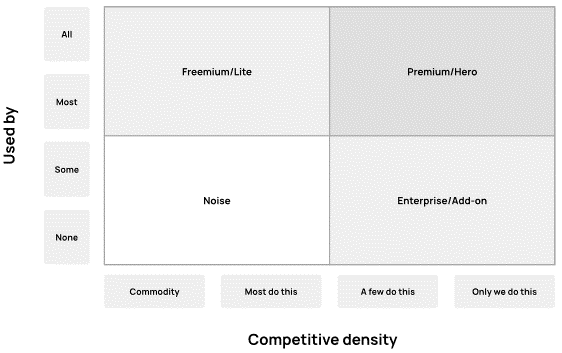When determining the right pricing strategy for your B2B SaaS product/services, I like to use a “Feature Matrix” exercise. I developed this tool after I left Microsoft. It is based on best practices I learned through my experience doing product marketing for Office 365. Your positioning, packaging, and pricing can all benefit from completing the exercise. You can use the insights to improve product planning, implement upsell strategies and clean up messaging to make it more relevant.
The model uses two axes. The X (horizontal) axis represents product differentiation. How unique is a particular feature? This axis moves from left to right, from “everybody offers a particular feature” (it is a commodity) to “only you offer it” (it is unique). The Y (vertical) axis tracks feature relevance or popularity. How many of these features are used by most of your potential customers? From bottom to top, the Y axis moves from one user to everybody.

By breaking down a feature matrix into quadrants, you can define the features that are important to the most customers. Those that are unique are the most valuable. The combined analysis is a powerful framework for pricing and packaging, but also for messaging, positioning, and marketing strategy. The above example is a SaaS solution for sales performance management. Product capabilities are listed on the “chips” and positioned inside the four quadrants. It is key to realize these are relative positions. There is no absolute value that can be assigned to these positions, and the main purpose is to learn what benefits or features are more unique or popular vs. others.
Quadrants of a Feature Pricing Matrix
Let’s explore these four quadrants a bit further. The lower left are features used by a small number of customers and offered by most competitive products. The upper left are features used by most customers and offered by most competing products. The lower right quadrant has features that are special—they are not offered by most of your competitors but are only needed by a small percentage of customers. The upper right is the most important quadrant. These are features that are used by most customers and offered by a small portion of the market. These are unique differentiators for your product.
Using a smartphone as an example, the capability of making a phone call would probably fall in the upper left. It is not unique, but everybody needs it—it is a feature that has become commoditized. Being able to take photos is something that most vendors offer but there might be a vendor here or there with a basic model that does not offer that. So that might be a reason to put that in the second column.
What is unique? If you think of Apple, they have some things like the retina display that are used by everybody but are also a real differentiator. That is something that people would pay money for. Those things that end up in the upper right quadrant are real differentiators. They matter to most of your audience.

It is critical to be aware of what is in the upper right. Also, there will be things that do not make it into the quadrant that are still valuable for a smaller group of customers. Those features fall into the lower right—things you want to sell and market but maybe not to everyone.
Knowing how your features and capabilities align with what your anticipated market is looking for—and how unique those things are—is an exercise that I recommend to anybody selling a relatively complex solution. Here are a couple more notes on each quadrant.
Noise: The lower left corner is the group of features that are not necessarily relevant for anybody, and they are not differentiators. Talking about these features represents noise in the marketplace. There is nothing that stands out, nothing to command anyone’s interest.
When I assess clients’ websites or sales and marketing collateral, I am amazed how often there are items that fall in the lower-left quadrant. This exercise is a great way to find and remove those things from your website and materials.
Freemium: You could have a lineup of products with capabilities that are needed by every customer but not that differentiated. Maybe you give those away for free. It is a great way to attract customers and allow people to get to know your product without having to pay for it yet.
Premium: This is the most profitable part of our value proposition, where the largest group of customers will spend the most money for the features offered. In addition to attracting customers to this quadrant, you want to use these features to upsell your Freemium prospects to Premium.

Add-ons: There may be a few customers willing to pay more for a specific capability. You can turn these into add-ons. Or you decide that maybe 10 percent of your customers need enterprise features and they become the lower right box.
With this model, the foundation is in place for you to identify the capabilities you can use to create different plans for value-based pricing. Another aspect of doing this exercise is that you can now think of your product planning as well. If you believe that what is in the upper right quadrant is what sets you apart, you want to make sure that you keep filling that quadrant.
That is something you do by building new capabilities that may not yet be used, relevant, or interesting to a large group of customers. So, maybe that new feature starts in the lower-right quadrant. That is where you innovate and test things with a smaller group of customers. As things catch on and become more popular, those new innovations make it to your Premium pricing plan in the upper right.
You also need to realize that those innovations will eventually get commoditized. Remember when the iPhone was the only smartphone with a camera? Now all smartphones have them. Realize that others will copy what you do. So, you need to figure out a way to keep filling that upper right quadrant with new capabilities.
This will be different from one industry to the next. If you are running a SaaS business, it is extremely critical that you keep filling the upper right quadrant. Because when you offer SaaS, you are literally asking people to pay you again tomorrow. Thus, you need to be able to add value again tomorrow. That is the handshake you do with your customers, especially when you want them to pay a year in advance.

Creating Your Own Feature Matrix
On the T2D3 Website, you can find a ready-to-use template for this exercise. Follow these important steps when using this tool:
- List your features and capabilities. Go to your website, review your sales materials, everything you say to the world. List the features and capabilities you are proud of, the things that are your superpowers, the things that you do best, that you do better than others.
- Rank them. In two dimensions, stack rank the things that you really believe are the reasons you are in business, the things that you do well. The vertical axis is equivalent to popularity. What part of the market that you serve needs this capability? The horizontal axis is equivalent to differentiation. How unique are the things that you do?
- Translate your list into a 2x2 matrix. What typically happens is that you will find your team is very proud of what you do and will place a lot of things in the upper right quadrant. So, you will have to normalize it (zoom in) to get a nice, scattered field.